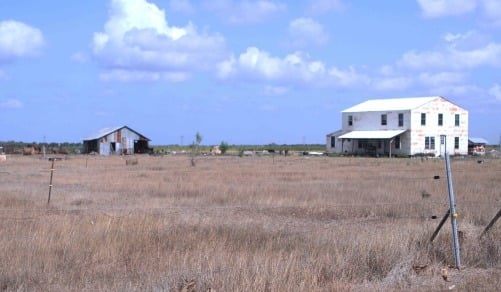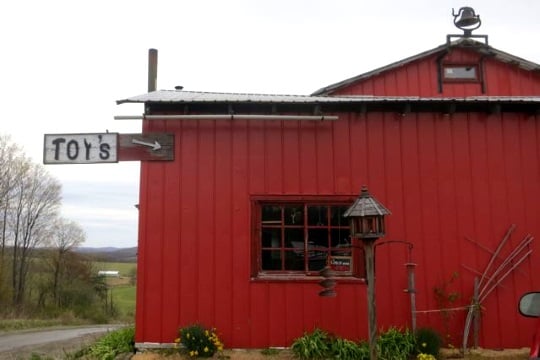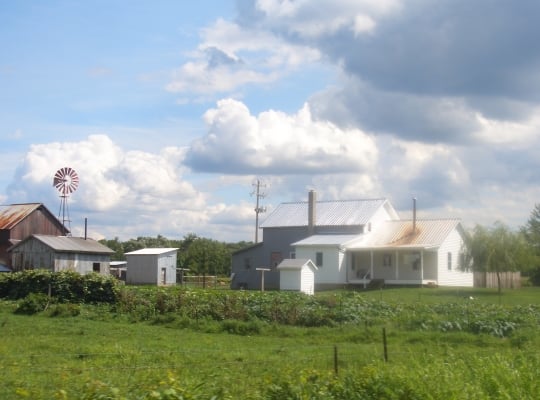5 Plain Amish Communities
In many ways, the Amish are not one uniform group. To take one example, there are material differences between churches and communities.
On one end, there are Amish who permit telephones in the home, regularly hire Amish taxi drivers to transport them for errands or to and from work, and who have homes which visually resemble non-Amish homes, with beautiful gardens and “English” architectural flair.

On the other, there are Amish who lack indoor plumbing, avoid landscaping or even gravel drives, and would only resort to taking a private vehicle in an emergency.

Sometimes you’ll see differences within Amish communities whose churches otherwise fellowship with one another (meaning formally cooperating on church matters, for instance by exchanging preachers).
One example would be the Amish in northern Indiana (Elkhart/Lagrange County).
There you find a range of churches, some of which are significantly more progressive, materially, than others (eg, churches near Shipshewana, a very progressive area, vs. those on the east end of the settlement or the “Barrens” area). However they all remain in fellowship with one another (with one possible small exception).
More often, if the material (or other) differences are drastic enough, churches will not fellowship with one another (at least not fully).
Five Plain Amish Settlements
The following 5 communities would generally all be on the “plain” end from a material standpoint (meaning technology permitted, appearance of homes, dress, etc).
In parentheses I’ve noted the date the settlement was founded, and number of church districts as of 2018.

1. Lodi, Ohio (1952, 15 church districts) – This is a Swartzentruber Amish settlement. The Swartzentruber Amish are usually the first group people think of when they think “plain.”
Due to various schisms there are different subgroups of Swartzentruber Amish – at least 3-4 – but generally all are considered among the plainest of all Amish.
This means all the visual markers like no plumbing in the homes, outhouses, no SMV triangle or electric lights on buggies, longer hair and beards on men, dark-colored clothing for both women and men (deep blue, maroon), along with cultural and religious markers like longer church services, slower singing, and a staunch resistance to change.
That noted, this group surprisingly began testing a noteworthy innovation last year.
Following a rash of buggy-car accidents, the Amish here began adopting a highly unusual way of marking their buggies.
The Lodi community is the largest Swartzentruber-only settlement (more total Swartzentruber Amish live in the nearby Holmes County community, but they are just one of around a dozen affiliations in that settlement). Read more.

2. Beeville, Texas (1999, 1 district) – This small community just a couple of hours from the Mexican border is unlike most other Amish areas in appearance.
The hardscrabble country does not lend itself to the kind of traditional dairies we associate with the Amish. The people here do some produce farming via irrigation. There are some small enterprises including a store, as well as some beekeeping.
The homes in the Beeville area have a plain and rough appearance, probably reflecting economic conditions as well as the group’s predilections. Read more on the Amish in Bee County.

3. Conewango Valley, New York (1949; 17 districts) – This is a community of Troyer Amish, one of the more traditional affiliations. The Troyer group split off from the Swartzentruber Amish in the 1930s.
Though they use the SMV triangle on their buggies, there are other markers of plainness – as Karen Johnson-Weiner notes in New York Amish, their homes have no “linoleum floors, carpeting, sofas, and other upholstered furniture. There are no indoor toilets, and homes are lit with oil lamps instead of gas or battery powered lamps.”
This is the largest and oldest Amish settlement in the Empire State. Read more.

4. Randolph, Mississippi (1995, 1 district) – This is a little Swartzentruber community in northern Mississippi. There are several Swartzentruber locations in the South. This one has ties to the Ethridge, Tennessee settlement.
This is the only Amish settlement in Mississippi, though Amish communities have existed here before on several other occasions, dating back to 1896. More on Amish in Mississippi.

5. Branch County, Michigan (1960; 8 districts) – This is a Swiss Amish settlement. Swiss Amish can be a mixed bag as far as plainness (read more about this special group of Amish, distinct from the majority Pennsylvania German-speaking Amish).
Some Swiss characteristics are far from plain – like the large brick houses found in Allen County, Indiana. Other more-or-less universal Swiss aspects could be considered plain – like the customary open buggy (hardly luxurious when it rains, though the Swiss tote large umbrellas for such situations), or their wooden grave markers.
I have visited several Swiss communities, including the two largest ones (Adams County, IN and Allen County, IN). One of the plainer of those Swiss settlements is that found in Branch County, Michigan.
As one of our readers noted, this daughter settlement leans more conservative than the two larger settlements. This was visibly evident, with dirt driveways, metal roofs, and an appearance which reminded me of Swartzentuber communities.
A nearby Swiss settlement at Quincy, MI stands in contrast as a more materially progressive place. More on the Amish of Branch County.
Here we’ve looked at communities that are identifiably plainer than more materially progressive Amish (such as those in Lancaster County, Jamesport, MO, or “Tractor Amish” settlements like Chouteau, OK or Kalona, IA, to name a few).
Of course, plainness in an Amish context is not just about visual characteristics, but also about mentality, adherence to tradition, and openness to change. In fact the way they look materially could be considered a reflection of these “invisible” characteristics.
Have you visited any plain Amish settlements? Let us know in the comments 🙂
Photo credits: Plain interior – Karen Johnson-Weiner; Beeville – Kelly Irvin; Conewango Valley – Tom; Randolph, MS – Erin Tracy











Milroy?
While I understand the Big Valley settlement in central PA is a combination of very conservative and more modern Amish – I can’t believe that this article didn’t discuss the “Nebraska” Amish who live around Milroy which is northeast of Belleville – the heart of the Big Valley. One can get off 322 at the Milroy exit and drive for several miles and just see the unpainted barns, the hardscrabble looking houses and the milk cans at the end of the driveways that indicate one is in a Nebraska settlement.
There are actually a lot that could have gone on this list; I just picked five 🙂
It is a plain group, I’ve been in that community several times, one of my favorites to visit. Good description of the area.
MN and WI
There are several in MN and WI.
Plain Amish
The Amish in Seymour, MO are quite plain. They wear only blues and browns, have outhouses, open buggies only. They are friendly and very kind but not as modern as some I have read about.
Branch County
I have not been to the Branch County settlement, but likely encountered some of their members in the Angola, Indiana Wal-mart when I was a student at Trine (then Tri-State) University (prior to becoming German Baptist). I did notice that all most all the Amish we ever saw at Wal-mart there were very plain. One I spoke to about hunting gear was from Michigan and was exceptionally plain, with safety pins closing his shirt (it was the older pullover style that would usually have two buttons, available from Gohn Bros.). I wonder if this group is connected to the Amish in Fremont, Indiana which I noticed was very plain as well. No buggies were ever at the Angola Wal-mart, just the usual taxis.
There is also a rather plain Amish community at Hamilton/Alvarado, Indiana, not too far southeast of Angola.
We probably saw the ones from Hamilton/Alvarado as well. I remember speaking to one man who was from Wakarusa, which is a bit of a hike from Angola.
Enjoy Comments
I enjoy reading the comments about the different Amish communities. I respect the Amish for their beliefs and living ways. I could not do as they do, but if we all tried to follow their way, I believe the world would be a better place.
Thanks Dick, glad to hear it. Generally speaking I agree there are a lot of positive aspects typical in Amish communities and families that many people want for today. Even if they don’t always realize it.
Plain Amish
We live in Northeastern lower Michigan near the towns of Hale and Whittemore. Our Amish neighbors are ‘plain’. They are friendly folk who keep nice farms. We have worked out a deal with them to get our fields hayed. We split the bales between us. Our nearest neighbor trains horses for buggy and plow.
Franklin County, Pa
There is a small community of very plain Amish in the Dry Run, Spring Run, Path Valley area in Franklin County Pa. They are extremely conservative using horses for everything, also in everyday activities. Are not considered swartzentruber but are about as conservative as I have ever seen. It would be interesting to see if Amish America could visit this area.